What is COPD?
Key Facts

COPD is the 3rd leading cause of death worldwide and 10th leading cause of death in Singapore.1,2
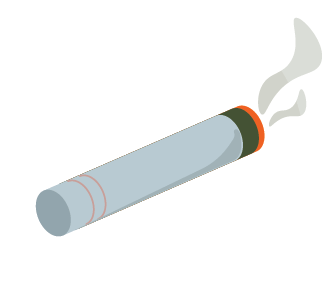
Tobacco smoking accounts for more than 80% of COPD cases in Singapore.3
Even "social" smoking is harmful.

It is important to prevent COPD flare-ups. Only 50% of patients remained alive within 3.6 years after their first COPD flare-up (that required hospitalisation)4.
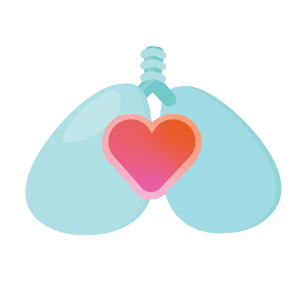
The heart and lungs are linked.5 COPD increases the risk of both heart and lung problems (known as 'cardiopulmonary risk')6,7.
Up to 44% of deaths in COPD patients were due to cardiac causes. 8-11
References:
- Ministry of Health. Principal Causes of Death. Available at: https://www.moh.gov.sg/resources-statistics/singapore-health-facts/principal-causes-of-death. Accessed on 13 Feb 2024.
- World Health Organization (WHO). The top 10 causes of death. 2020. Available at: https://www.who.int/news-room/fact-sheets/detail/the-top-10-causes-of-death. Accessed on 14 June 2023.
- KK Women’s and Children’s Hospital. Huff and puff of an incurable disease. Available at: https://www.kkh.com.sg/news/others/copd-huff-and-puff-of-an-incurable-disease. Accessed on 30 May 2024.
- Suissa S et al. Thorax. 2012;67:957-963.;.
- American Lung Association. Your Heart and Lungs: The Ultimate Relationship (2023) Available at: https://www.lung.org/blog/heart-lung-relationship. Accessed on 30 May 2024.
- Donaldson GC et al. Chest. 2010;137:1091-1097;9-2029.
- Singh D et al. Adv Ther. 2024 Jun;41(6):2151-2167.
- Anthonisen NR et al. Ann Int Med. 2005;142:233-239.
- Calverly PMA et al. N Engl J Med. 2007;356:775-789.
- Lipson DA et al. Article and data supplement. Am J Respir Crit Care Med. 2020;201(12):1508-1516.
- Rabe KF et al. Article and supplementary appendix. N Engl J Med. 2020;383:35-48.
- World Health Organisation (WHO). Chronic obstructive pulmonary disease (COPD). Available at: https://www.who.int/news-room/fact-sheets/detail/chronic-obstructive-pulmonary-disease-(copd). Accessed on 30 May 2024.
- US Department of Health and Human Services. National Institute of Mental Health (NIMH) Web site. https://www.nhlbi.nih.gov/health/copd. Accessed on 30 May 2024.
- Diab N, et al. Am J Respir Crit Care Med. 2018;198:1130–1139.
Overview
Chronic Obstructive Pulmonary Disease (COPD) is a progressive, long-term lung disease that makes it difficult for the patient to breathe. “Progressive” means the disease gets worse over time. COPD is also sometimes described as emphysema or chronic bronchitis.12 It often results from a combination of risk factors, such as tobacco exposure (from smoking or second-hand smoke), environmental air pollution (indoor or outdoor), or even genetic factors.12
People with COPD may experience wheezing, shortness of breath, chest tightness and have a persistent cough that often has phlegm.12
Healthy airways and air sacs are elastic (stretchy). This helps the air sacs to expand and fill with air when we breathe in, and to deflate as we breathe out.13 In COPD, less air flows in and out of the airways because of one or more of the following12:
- The airways and air sacs become less elastic
- The walls between many of the air sacs are destroyed
- The walls of the airways become thick, inflamed and swollen
- The airways make more mucus than normal, blocking the passage
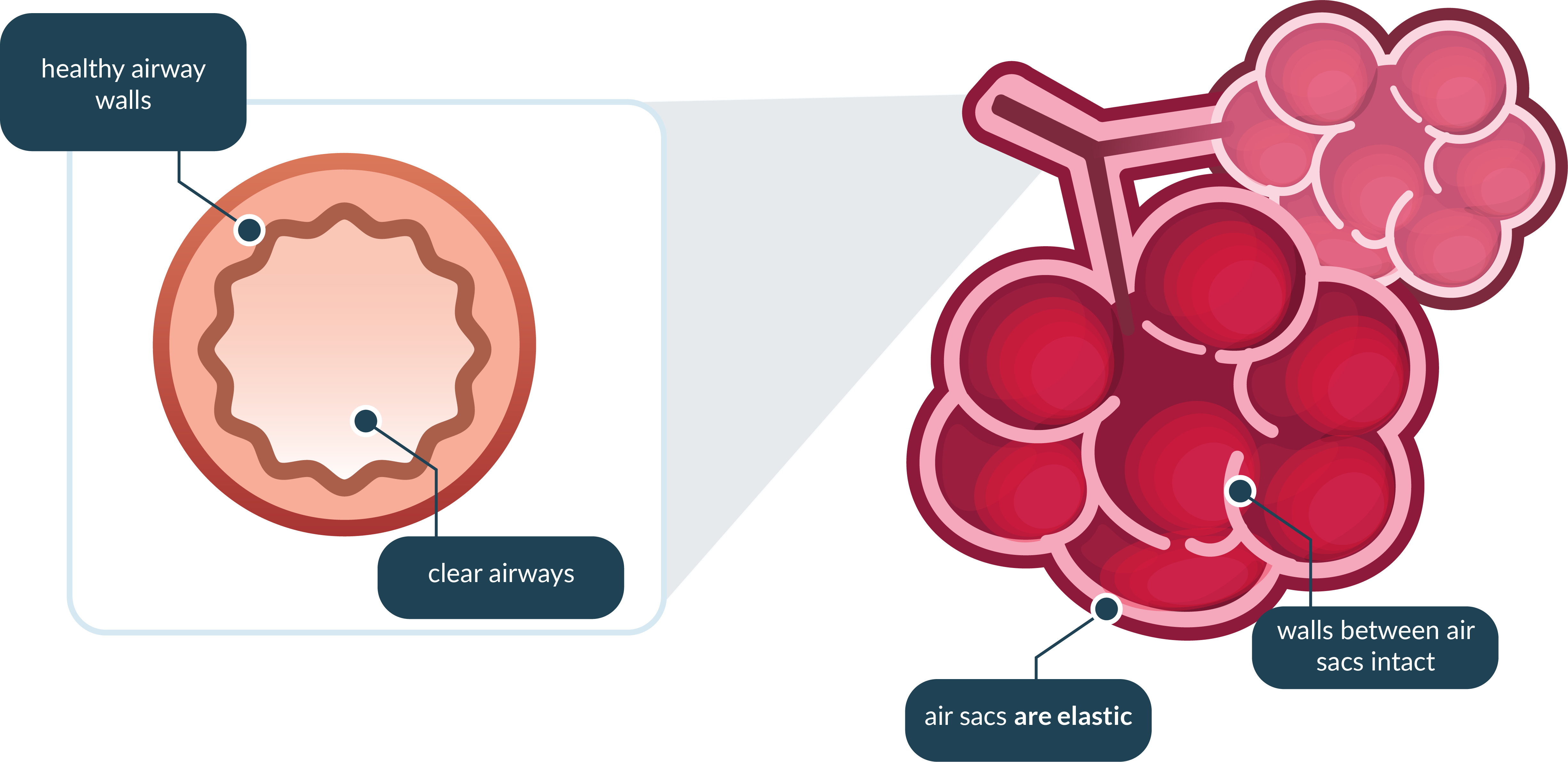
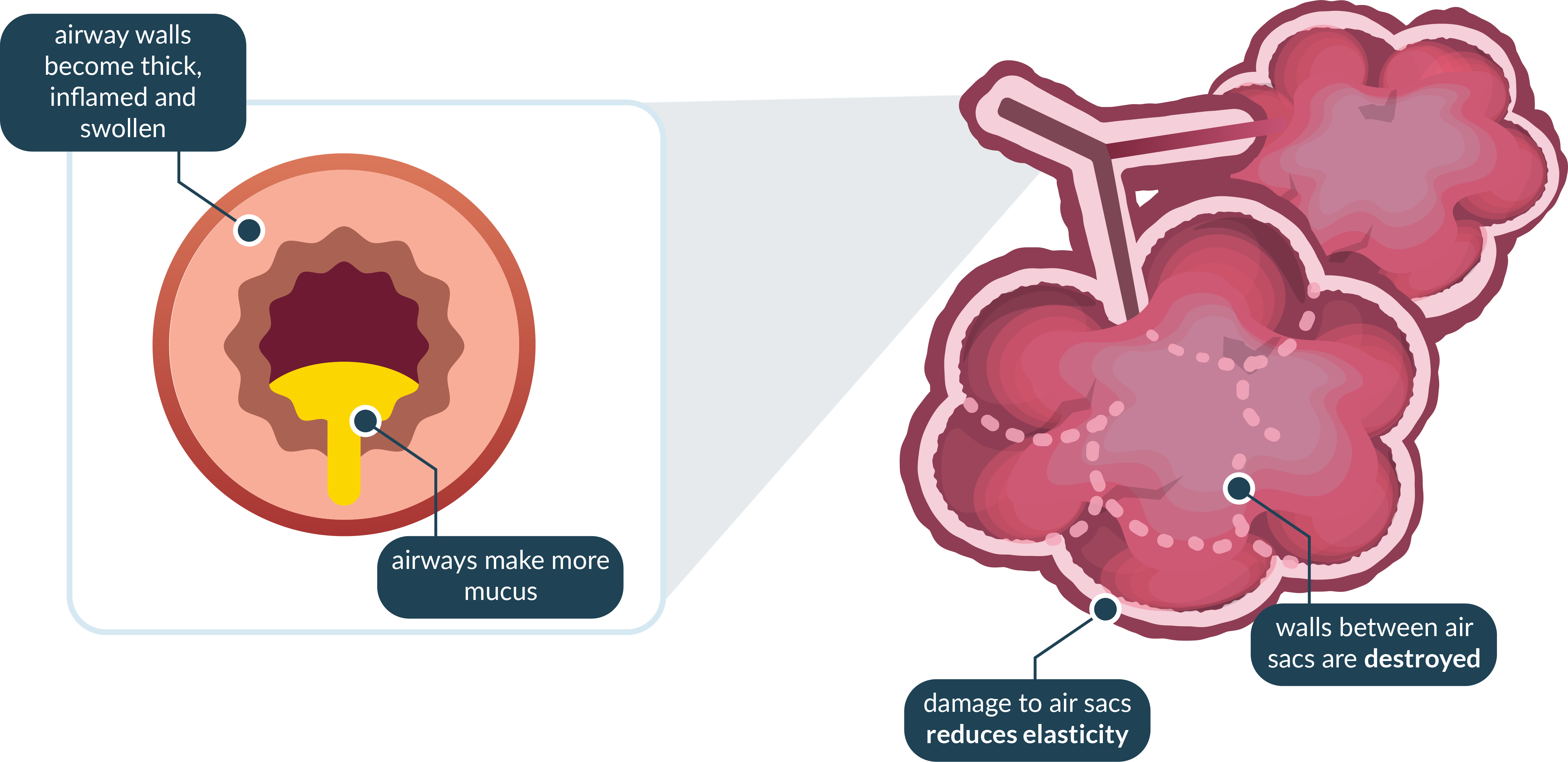
References:
- Ministry of Health. Principal Causes of Death. Available at: https://www.moh.gov.sg/resources-statistics/singapore-health-facts/principal-causes-of-death. Accessed on 13 Feb 2024.
- World Health Organization (WHO). The top 10 causes of death. 2020. Available at: https://www.who.int/news-room/fact-sheets/detail/the-top-10-causes-of-death. Accessed on 14 June 2023.
- KK Women’s and Children’s Hospital. Huff and puff of an incurable disease. Available at: https://www.kkh.com.sg/news/others/copd-huff-and-puff-of-an-incurable-disease. Accessed on 30 May 2024.
- Suissa S et al. Thorax. 2012;67:957-963.;.
- American Lung Association. Your Heart and Lungs: The Ultimate Relationship (2023) Available at: https://www.lung.org/blog/heart-lung-relationship. Accessed on 30 May 2024.
- Donaldson GC et al. Chest. 2010;137:1091-1097;9-2029.
- Singh D et al. Adv Ther. 2024 Jun;41(6):2151-2167.
- Anthonisen NR et al. Ann Int Med. 2005;142:233-239.
- Calverly PMA et al. N Engl J Med. 2007;356:775-789.
- Lipson DA et al. Article and data supplement. Am J Respir Crit Care Med. 2020;201(12):1508-1516.
- Rabe KF et al. Article and supplementary appendix. N Engl J Med. 2020;383:35-48.
- World Health Organisation (WHO). Chronic obstructive pulmonary disease (COPD). Available at: https://www.who.int/news-room/fact-sheets/detail/chronic-obstructive-pulmonary-disease-(copd). Accessed on 30 May 2024.
- US Department of Health and Human Services. National Institute of Mental Health (NIMH) Web site. https://www.nhlbi.nih.gov/health/copd. Accessed on 30 May 2024.
- Diab N, et al. Am J Respir Crit Care Med. 2018;198:1130–1139.
Signs and Symptoms
In the early stages, COPD may cause only mild symptoms. As the disease gets worse, symptoms usually become more severe. It can eventually limit your ability to do daily activities (such as walking or cooking)13
Common signs and symptoms of COPD include13:

Shortness of breath, especially with physical activity

An ongoing cough that usually produces a lot of phlegm
(often called “smoker’s cough”)
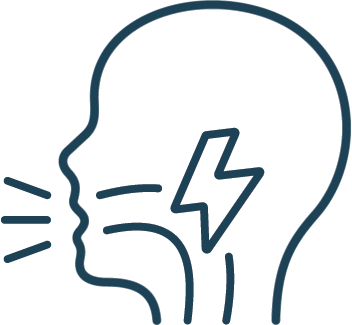
Wheezing
(a whistling or squeaky sound when you breathe)
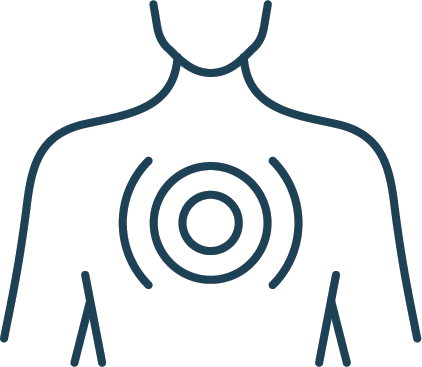
Chest tightness
People with COPD may also develop colds or flu more often.
Severe COPD may also cause other symptoms, such as swelling in your ankles or feet, weight loss, and reduced muscle endurance. Severe symptoms may require treatment in a hospital.
You should seek emergency care if13:- You are having a hard time catching your breath or talking
- Your lips or fingernails turn blue or gray – this is a sign of low blood oxygen levels
- People around you observe that you are not mentally alert
- Your heartbeat is very fast
- The treatment prescribed for your symptoms is not working

References:
- Ministry of Health. Principal Causes of Death. Available at: https://www.moh.gov.sg/resources-statistics/singapore-health-facts/principal-causes-of-death. Accessed on 13 Feb 2024.
- World Health Organization (WHO). The top 10 causes of death. 2020. Available at: https://www.who.int/news-room/fact-sheets/detail/the-top-10-causes-of-death. Accessed on 14 June 2023.
- KK Women’s and Children’s Hospital. Huff and puff of an incurable disease. Available at: https://www.kkh.com.sg/news/others/copd-huff-and-puff-of-an-incurable-disease. Accessed on 30 May 2024.
- Suissa S et al. Thorax. 2012;67:957-963.;.
- American Lung Association. Your Heart and Lungs: The Ultimate Relationship (2023) Available at: https://www.lung.org/blog/heart-lung-relationship. Accessed on 30 May 2024.
- Donaldson GC et al. Chest. 2010;137:1091-1097;9-2029.
- Singh D et al. Adv Ther. 2024 Jun;41(6):2151-2167.
- Anthonisen NR et al. Ann Int Med. 2005;142:233-239.
- Calverly PMA et al. N Engl J Med. 2007;356:775-789.
- Lipson DA et al. Article and data supplement. Am J Respir Crit Care Med. 2020;201(12):1508-1516.
- Rabe KF et al. Article and supplementary appendix. N Engl J Med. 2020;383:35-48.
- World Health Organisation (WHO). Chronic obstructive pulmonary disease (COPD). Available at: https://www.who.int/news-room/fact-sheets/detail/chronic-obstructive-pulmonary-disease-(copd). Accessed on 30 May 2024.
- US Department of Health and Human Services. National Institute of Mental Health (NIMH) Web site. https://www.nhlbi.nih.gov/health/copd. Accessed on 30 May 2024.
- Diab N, et al. Am J Respir Crit Care Med. 2018;198:1130–1139.
COPD Flare-ups
A COPD flare-up (or exacerbation) is a sudden worsening of your condition over a few days, requiring additional therapy. You may experience worsening breathlessness and/or increased cough with phlegm that cannot be addressed by your usual medications. Other signs such as increased heart rate may also be present.
Common triggers of flare-ups include:13,14
- Airway infection
- Air pollution
- Cold air
- Certain smells
Flare-ups are linked to complications such as (but not limited to):4,7
- Increased risk of the next flare-up
- Faster decline in lung function
- Heart attacks, or worsening of existing heart condition (e.g. heart failure)
Severe flare-ups can even be life-threatening.4,7 It is thus important to prevent even the first COPD flare-up from happening.
References:
- Ministry of Health. Principal Causes of Death. Available at: https://www.moh.gov.sg/resources-statistics/singapore-health-facts/principal-causes-of-death. Accessed on 13 Feb 2024.
- World Health Organization (WHO). The top 10 causes of death. 2020. Available at: https://www.who.int/news-room/fact-sheets/detail/the-top-10-causes-of-death. Accessed on 14 June 2023.
- KK Women’s and Children’s Hospital. Huff and puff of an incurable disease. Available at: https://www.kkh.com.sg/news/others/copd-huff-and-puff-of-an-incurable-disease. Accessed on 30 May 2024.
- Suissa S et al. Thorax. 2012;67:957-963.;.
- American Lung Association. Your Heart and Lungs: The Ultimate Relationship (2023) Available at: https://www.lung.org/blog/heart-lung-relationship. Accessed on 30 May 2024.
- Donaldson GC et al. Chest. 2010;137:1091-1097;9-2029.
- Singh D et al. Adv Ther. 2024 Jun;41(6):2151-2167.
- Anthonisen NR et al. Ann Int Med. 2005;142:233-239.
- Calverly PMA et al. N Engl J Med. 2007;356:775-789.
- Lipson DA et al. Article and data supplement. Am J Respir Crit Care Med. 2020;201(12):1508-1516.
- Rabe KF et al. Article and supplementary appendix. N Engl J Med. 2020;383:35-48.
- World Health Organisation (WHO). Chronic obstructive pulmonary disease (COPD). Available at: https://www.who.int/news-room/fact-sheets/detail/chronic-obstructive-pulmonary-disease-(copd). Accessed on 30 May 2024.
- US Department of Health and Human Services. National Institute of Mental Health (NIMH) Web site. https://www.nhlbi.nih.gov/health/copd. Accessed on 30 May 2024.
- Diab N, et al. Am J Respir Crit Care Med. 2018;198:1130–1139.
The Heart-Lung Relationship
 Figure adapted from Singh et al. Adv Ther. 2024
Figure adapted from Singh et al. Adv Ther. 2024
- People with worse COPD symptoms have a higher risk of flare-ups7
- As the heart and lungs are linked, these flare-ups can also lead to heart problems (e.g. heart attacks, worsening of existing heart failure)7
- Both COPD flare-ups and heart problems may increase the risk of early death.7

COPD Outlook
COPD develops slowly and is often diagnosed later in life. Due to delays in diagnosis, many people may have the disease and not even know it.14
Although the damage to lungs in COPD is not fully reversible, treatments and lifestyle changes can help you feel better, stay more active, and slow down the progression of the disease.13
References:
- Ministry of Health. Principal Causes of Death. Available at: https://www.moh.gov.sg/resources-statistics/singapore-health-facts/principal-causes-of-death. Accessed on 13 Feb 2024.
- World Health Organization (WHO). The top 10 causes of death. 2020. Available at: https://www.who.int/news-room/fact-sheets/detail/the-top-10-causes-of-death. Accessed on 14 June 2023.
- KK Women’s and Children’s Hospital. Huff and puff of an incurable disease. Available at: https://www.kkh.com.sg/news/others/copd-huff-and-puff-of-an-incurable-disease. Accessed on 30 May 2024.
- Suissa S et al. Thorax. 2012;67:957-963.;.
- American Lung Association. Your Heart and Lungs: The Ultimate Relationship (2023) Available at: https://www.lung.org/blog/heart-lung-relationship. Accessed on 30 May 2024.
- Donaldson GC et al. Chest. 2010;137:1091-1097;9-2029.
- Singh D et al. Adv Ther. 2024 Jun;41(6):2151-2167.
- Anthonisen NR et al. Ann Int Med. 2005;142:233-239.
- Calverly PMA et al. N Engl J Med. 2007;356:775-789.
- Lipson DA et al. Article and data supplement. Am J Respir Crit Care Med. 2020;201(12):1508-1516.
- Rabe KF et al. Article and supplementary appendix. N Engl J Med. 2020;383:35-48.
- World Health Organisation (WHO). Chronic obstructive pulmonary disease (COPD). Available at: https://www.who.int/news-room/fact-sheets/detail/chronic-obstructive-pulmonary-disease-(copd). Accessed on 30 May 2024.
- US Department of Health and Human Services. National Institute of Mental Health (NIMH) Web site. https://www.nhlbi.nih.gov/health/copd. Accessed on 30 May 2024.
- Diab N, et al. Am J Respir Crit Care Med. 2018;198:1130–1139.


